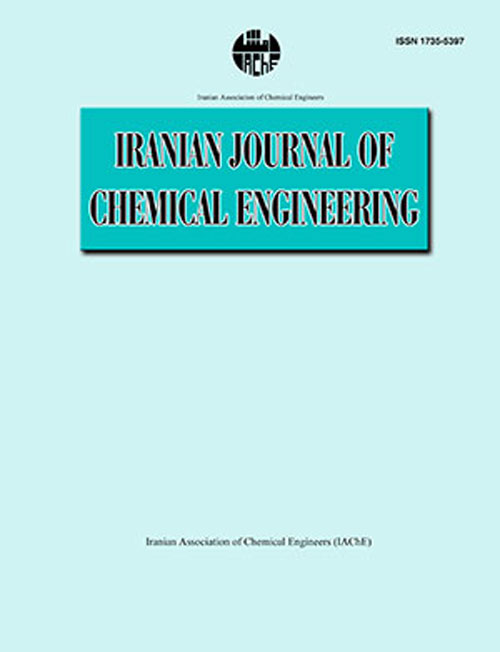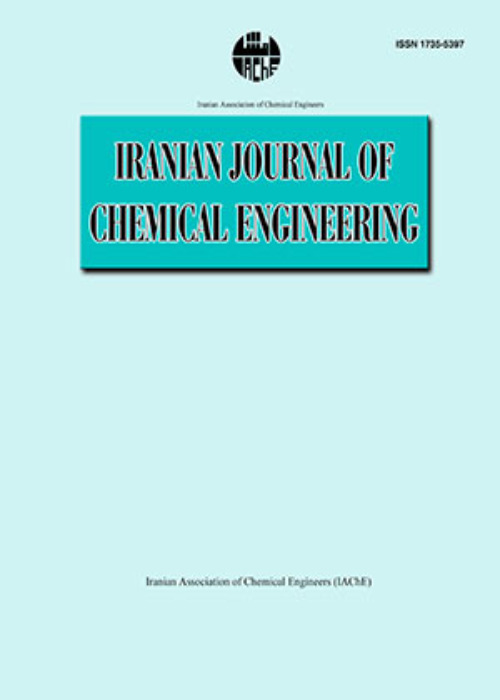فهرست مطالب

Iranian journal of chemical engineering
Volume:14 Issue: 3, Summer 2017
- تاریخ انتشار: 1396/07/17
- تعداد عناوین: 7
-
-
Pages 3-18Joule-Thomson cooling systems are used in refrigeration and liquefaction processes. There are extensive studies on Joule-Thomson cryogenic systems, but most of them coverage steady state conditions or lack from experimental data. In the present work, transient thermal behavior of Joule-Thomson cooling system including counter current helically coiled tube in tube heat exchanger, expansion valve, and collector was studied by experimental tests and simulations. The experiments were carried out by small gas liquefier and nitrogen gas as working fluid. The recuperative heat exchanger was thermally analyzed by experimental data obtained from gas liquefier. In addition, the simulations were performed by an innovative method using experimental data as variable boundary conditions. A comparison was done between presented and conventional methods. The effect of collector mass and convection heat transfer coefficient was also studied using temperature profiles along the heat exchanger. The higher convection heat transfer coefficient in low-pressure gas leads to increase in exchanging energy between two streams and faster cooling of heat exchanger materials, but the higher convection heat transfer coefficient in high-pressure gas does not influence on cool-down process.Keywords: heat exchanger, Joule-Thomson, transient, cryogenic, refrigeration
-
Pages 19-30In recent years, plasma treatments have given good results since they offer high technological efficiency with low waste generation. One of the most important characteristics of plasma methods is their action only on a thin surface layer, whereas the bulk of sample remains unchanged and the modified material keeps its chemical and mechanical properties. In this research, polyurethane membrane surface was modified by low frequency plasma grafting with methacrylic acid and acrylamide monomers to alter solution-diffusion mechanism. We chose different parameters of plasma treatment and studied their effects toward maximum solubility, permeation and selectivity. The grafting on the surfaces was characterized by water contact angle measurement and atomic force microscopy. After confirming a successful grafting, we studied the effect of surface modification on permeation of CH4 and CO2. Significant increase in CO2 permeation and about 32 percent increase in CO2/CH4 selectivity was observed. Better results were obtained for low powers and acrylamide grafted surface.Keywords: Surface modification, Plasma applications, Grafting, Selective permeation, Polyurethane
-
Pages 31-40In this study adsorption of Cr(VI) from aqueous solution by Fe3O4 nanoparticles was investigated. Desorption process and recovery of nanoparticles using different solutions were then carried out, and it was observed that NaOH (0.5M) can remove 90% of adsorbed chromium ions. Following the completion of adsorption/ desorption cycles, it was determined that nanoparticles have still had a high ability of chromium ions adsorption after 4 cycles. In addition, it was found that when iron oxide nanoparticles were washed with NaOH solution, the adsorption efficiency increases in the next cycle. FTIR spectra and zeta potential analysis, demonstrated the increased in surface positively charged of nanoparticles leads to increased electrostatic attraction forces between the iron oxide nanoparticles and chromium ions which finally resulted in adsorption increasing. So in this research, pretreatment of nanoparticles with NaOH solution modifies the surface of Fe3O4 nanoparticles by increasing surface positively charged mechanism and the adsorption efficiency has improved in the next cycle.Keywords: Heavy metals, Adsorption, Iron oxide nanoparticles, Desorption, Adsorption mechanism
-
Pages 41-54Due to the importance of nanoparticles stability in industrial applications, in this research, stability of laponite nanoparticles dispersions containing different concentrations of sodium sulfonated polyacrylamide (SPA) was investigated in electrolyte media for oil reservoirs applications. In this regard, effect of parameters such as polymer concentration, temperature, and ionic strength were studied via different methods such as Fourier transform infrared (FT-IR) spectroscopy, dynamic light scattering (DLS) and zeta potential. In FT-IR spectra of SPA-laponite dispersion, in addition to typical peaks of laponite, there was a weak peak at 1040cm-1 characterizing SPA polymer. The z-average particle sizes of laponite particles increased after 168 h of aging in presence of SPA polymer. Zeta potential measurements showed that, adsorption of anionic groups of polymer on particle surface during the aging process has led to a decrease in zeta potential value (toward more negative values). It was seen that dispersion stability depended on polymer concentration, ionic strength of aqueous media, and temperature. Visual observations showed that the stability of laponite nanoparticles in electrolyte media was improved by increasing the SPA polymer concentration. The rheological studies showed that the viscosity curves of SPA-laponite dispersions were located below those of the corresponding pure SPA polymer solutions. Consequently, particle settling was hindered by increasing the polymeric matrix viscosity. Furthermore, using a power-law equation fitted to the polymer solution viscosity-shear rate data, it was shown that laponite nanoparticles stability in electrolyte media could be improved by decreasing the power-law coefficient.Keywords: Sulfonated polyacrylamide, Laponite Nanoparticle, Dispersion, Rheology, Electrolyte, Stability
-
Pages 55-64In this work, the role of appropriate mixing for mercaptan removal from Kerosene using caustic soda has been investigated in the pilot scale. Static mixer at different condition has been used as a passive mixing tool to achieve proper mixing and consequently high performance of mercaptan removal. Two lengths of static mixer including 20 and 40 cm as well as two pitches 1 and 3 mm were considered in a straight line. NaOH was injected to the Kerosene line to remove ( convert it to disulfide) the mercaptan. The effect of mixer length, mixer element pitch at different flow rates of Kerosene, including 2, 18 and 30 mL/s was investigated on the mercaptan removal. The experimental results showed that the concentration of mercaptan in the pilot line outlet will decrease as the flow rates of Kerosene decreases. Also, at a fixed flow rate of Kerosene, increasing the length of the static mixer and decreasing its element pitch caused the mercaptan to decrease due to proper mixing. Computational Fluid Dynamics (CFD) modeling technique was employed to describe the experimental results, fluid flow pattern, and mixing performance. Qualitative predicted results of CFD modeling show a good agreement with the experimental data.Keywords: mercaptan, static mixer, kerosene, mixer characteristics, Computational Fluid Dynamics (CFD)
-
Pages 65-81In this work, we prepared the nafion/montmorillonite/heteropolyacid nanocomposite membranes for direct methanol fuel cells (DMFCs). The analyses such as X-ray diffraction (XRD), Fourier transform infrared (FTIR), and scanning electron microscopy (SEM) were conducted to characterize the filler dispersion and membrane structure in prepared nanocomposite membranes. XRD patterns of nafion-CsPW-MMT nanocomposites membranes showed the exfoliated structure of membranes by adding MMT and CsPW. SEM-EDXA results showed proper dispersion of nanoparticles in the membrane matrices. Addition of CsPW-MMT to nafion membranes increases water uptake and IEC due to increase hydrophilic groups in membranes. The proton conductivity results showed that proton conductivity increases by increasing amount of CsPW and decreasing of clay content in the membrane. Methanol crossover through polymer electrolyte membranes is a critical issue and causes an important reduction of performance in DMFCs. The developed intercalated nafion/CsPW/MMT nanocomposite membranes have successfully improved the membrane barrier properties due to the unique feature of MMT which contributed to the formation of a longer pathway towards methanol across the membrane. The lowest methanol crossover of the developed membranes in this study was 1.651×10-6 cm2 s-1 which was lower than re-cast nafion membrane (2.078×10-6 cm2 s-1). The methanol permeability was significantly reduced by the incorporation of MMT and increased by addition of CsPW in the nafion membrane. Finally, according to the selectivity results, the nafion-MMT-CsPW nanocomposite membrane with MMT mass fraction of 2.5% and CsPW mass fraction of 8% shows the best membrane selectivity and this nanocomposite membrane could be suitable for application in DMFCs.Keywords: Nafion, Heteropolyacid, Montmorillonite, Proton Exchange Membrane, Methanol Crossover, Selectivity, Direct Methanol Fuel Cell
-
Pages 82-95The droplet size distribution in the column is usually represented as the average volume to surface area, known as the Sauter mean drop diameter. It is a key variable in the extraction column design. A study of the drop size distribution and Sauter-mean drop diameter for a liquid-liquid extraction column has been presented for a range of operating conditions and three different liquid-liquid systems. The effects of rotor speed, and dispersed and continuous phase velocities on drop size are investigated. Drop size distribution are appropriately described using the normal and log-normal probability density functions. The mathematical approach is used to determine the constant parameters in these functions and to provide the fit of the experimental data with them. and empirical expressions are derived to predict the parameters of the distribution curve as a function of operating variables, and physical properties of the systems. Good agreement between the prediction and experiments was achieved for all investigated operating conditions. An empirical correlation is also proposed to predict the Sauter-mean drop diameter with mean deviation of 9.8%.Keywords: Liquid-liquid extraction column, Sauter-mean drop diameter, drop size distribution, liquid-liquid extraction


